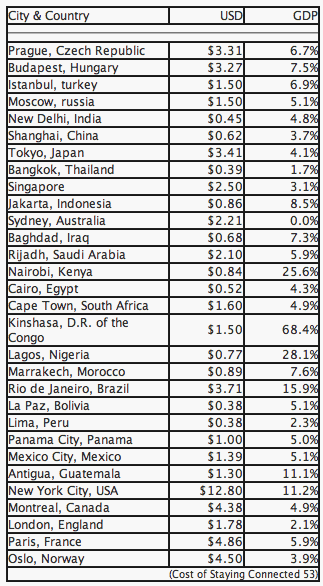I’m not sure what the story is here. I suspect that there are several, and that none of them could be irrefutably defended — Hoffman! –. But I feel that there is something important in these numbers in terms of an understanding that investing in today’s future requires investing in our intellectual capital, investing in people and their information skills and their ability and opportunity to engage in life-long-learning.
It’s a short piece in this month’s WIRED Magazine called The Cost of Staying Connected. The article features a map of the world, with lines pointing to various spots around the world and listing the local cost of Internet cafe time in US dollars and at the percent of daily purchasing power per capita (GDP). The article is not yet available online, but here is a list of locations and prices, starting a twelve o’clock and going around the world clockwise.

There are certainly a lot of holes in this map that would further enrich or define the story. I also understand that Internet usage in other countries is more of a social endeavor, that it is rare to have access to the Internet at home, and that people surf, answer questions, solve problems, together as a group endeavor at the local cybercafe.
I was also recently struck by the price of public web surfing when exploring the American Airlines web site. In a listing of all the airport Admirals Club revealed that all U.S. sites served Internet access through T-Mobile ($6.00/hour), and that all non-US sites offered WiFi for free.
Again, normal market influences may account for much of this data. At the same time, the cost in percent of daily purchasing power indicates a potential for digital divide.
You can view a sort by cost in US dollars and also a sort by cost in purchasing power.
Accord to these sortings, the six countries where an hour of public access to the Internet costs more than ten percent of the daily purchasing power are:
- The Congo
- Nigeria
- Kenya
- Brazil
- U.S.A.
- Guatemala
“The Cost of Staying Connected: Internet Cafe Prices are all over the Map.” Wired Magazine May 2006: 53.

 There is a question that continues to haunt me as I continue my evangelizing for a mix-it yourself media world. Hands-down, one of the most impressive aspects of Web 2.0 is the aggregator concept, and our ability to mix and remix content into personal digital newspapers. The question remains, though, “Aren’t we going to exclusively attract news and content that agrees with our world view and ignore the contrary arguments and evidence?”
There is a question that continues to haunt me as I continue my evangelizing for a mix-it yourself media world. Hands-down, one of the most impressive aspects of Web 2.0 is the aggregator concept, and our ability to mix and remix content into personal digital newspapers. The question remains, though, “Aren’t we going to exclusively attract news and content that agrees with our world view and ignore the contrary arguments and evidence?”